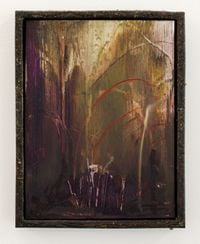
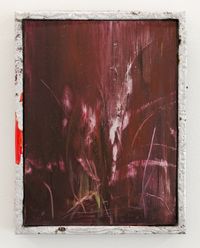
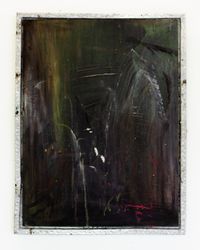
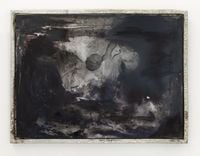
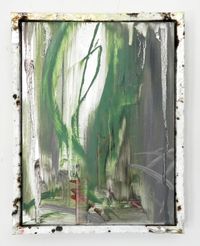
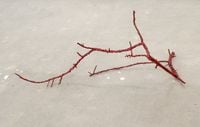
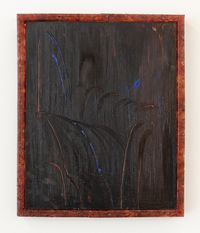
We and the trees
Tyne Gordon's Suntrap explores the landscape and the body, and the space in between. The works are led by the alchemical processes and performances of chemical reaction, while also referencing the relation between body and landscape.
Gordon approaches making with intuition, meditation and method. She starts the making process from alchemy, such as heating up solid pewter to its liquid state, then making a frame or form from its molten matter. As it hardens, Gordon leaves it be — the impurities the heat has created on the surface remain. It is consciously imperfect. During this process, Gordon finds a balance between the materials' natural behaviours and formations, and her own deliberate interruption of process. She guides them into a form or frame for her finished piece.
A key work in the exhibition is Soft Machine, a metal tapestry that plays with the various lights of the sun, casting shadows with different scales, densities and directions. It is made from melted pewter cups. The liquid pewter is poured into clay molds, made by Gordon through rolling out clay and indenting it with her fingers. Gordon mixes the earth (clay) with the elements (pewter). The human, bodily element to her work is evident in the result — you can see her pressed fingers on the surface of the snaked pewter tapestry. Soft Machine is designed with the gallery space in mind. Any visitor to the gallery will notice the long row of windows. It is a suntrap.
The paintings in Suntrap are copper and aluminium panels painted with oil and acrylic. Large gestural swoops of paint meet smaller, very intentional mark-making. Deep maroons, blood reds, and tinges of blue in Water (soft), mix with greens, silvers and grey in works like Dirt Aisle. They are reminiscent of anatomy: muscles, blood, fat, but also the earth: green grass, swampy water, trees and dappled light.
Gordon creates until a synergy is found, and a moment is captured. It's important that an equilibrium of binaries is met — liquid and solid, transparency and opacity, figuration and abstraction — before the work is completed.
Key to her practice, the artist flips the typical and historical function of the frame — to help preserve and protect the painting — on its head. The metal and resin frames wobble and snake around the works, pushing the painting between 2D and 3D, so they sit in each dimension.
For Suntrap, the frames have additions of tarnished steel, cellophane, tar seal, silver and gold leaf, carpet, moss, lichen, and plastic tubing. The textures hold variety, and come from an obsession with surface. They also nod to the everyday — we drive on tar seal, we wrap a bottle of bubbly in cellophane. The frames envelop the paintings.
The artist's previous works were influenced by certain landscapes. For Suntrap, Gordon focuses less on specificity, and more on the feeling of the space, in particular the bodily feeling of being cocooned by natural surroundings. An orchard is noted by Gordon, however where it is and what it grows are not crucial to the work overall. Rather, its twisting trunks and branches and layering of organic similarity are important.
Gordon's observations of the orchard and the link between branches, and roots and blood and veins is obvious in Swelter. The branch was picked for its almost-symmetrical form and angular structure, combined with its placement on the orchard floor — like a piece of furniture. The branch has now been coated in resin and cellophane. The result is a garish, synthetic object of nature, abstracting its organic roots. Is this an item of this world, or somewhere else? Gordon pushes the branch into another, more vermillion, realm.
Gordon's work is emotionally complex, asks questions of domesticity and manufacture, of specificity and generalisation. At the end, I'm not sure we have many answers. But one thing sticks, like resin to cellophane: we and the trees, we both have blood and veins.
Lucy Jackson
Level 1, Mibar Building
85 Victoria Street
Wellington, 6011
New Zealand
www.jhanamillers.com
0211670896
Wednesday–Friday: 11am–5pm
Saturday: 11am–4pm
or by appointment